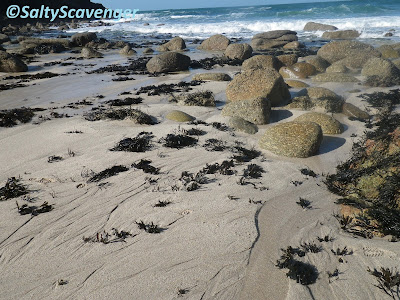Continued from the previous blog:
 |
| The rocky shore in March, 2016 has changed from that observed in June, 2015 with increased sand deposition and reduced seaweed cover and rockpool abundance. |
The habitats encountered are consistent with those previously recorded in September 2015 but the distribution and extent of each habitat has changed.
Habitat classification:
Substrate
|
LR (Littoral rock)
|
LS (Littoral Sediments)
|
|||||
Habitat
|
LR.HLR (High energy littoral rock)
|
LR.MLR (Moderate energy littoral rock)
|
LR.FLR (Features of littoral rock)
|
LS.Lsa (Littoral Sand)
|
|||
Biotope complex
|
LR.HLR.MusB (Mussel and/or barnacle communities)
|
LR.MLR.BF (Barnacles and fucoids on moderately
exposed shores)
|
LR.FLR.Rkp (Rockpools)
|
LR.FLR.Eph (Ephemeral green or red seaweed
communities)
|
LR.FLR.Lic (Lichens and small green algae on
suprallitoral and littoral fringe rock)
|
||
Biotope
|
LR.MLR.BF.Fser.R (Fucus serratus and red seaweeds
on moderately exposed lower eulittoral rock)
|
LR.FLR.Rkp.Cor (Coralline crust dominated shallow
eulittoral rockpools)
|
LR.FLR.Rkp.SwSed (Seaweeds in sediment-floored
eulittoral rockpools)
|
||||
Below are images of organisms you may encounter whilst rockpooling in these habitats:
 Small and rough periwinkles occur among these boulders.  Rough periwinkle (Littorina sp)  |
Increased sand deposits have formed a sandy area in the left hand side of the bay's upper shore. Habitat classification: LS.Lsa (Littoral Sand).
The distribution of organisms has changed in response to the sand deposition, with many gastropods taking to the cliff walls and extending further up the cliff than would usually be encountered.
|
 |
| The rocks to the right of the bay have not experienced the same amount of sand deposition and hence support habitats similar to that observed during previous rockpooling visits. Ephemeral green and red seaweeds cover boulders of the upper to mid shore, with barnacles throughout. The bedrock also supports ephemeral greens such as Ulva sp and Cladophora sp, especially where influenced by the fresh water runoff from the river. Lastly the patches of the lower shore support a canopy of Fucus serratus under which reds can be found. Habitat classification: LR.FLR.Eph (Ephemeral green or, red seaweeds (Fresh water or sand influenced) EUNIS: A1.45 and LR.FLR.Rkp (Rockpools) EUNIS: A1.41,LR.MLR.BF (Barnacles and fucoids on moderately exposed shores) EUNIS: A1.21 and LR.FLR.Rkp (Rockpools) EUNIS: A1.4. |
Coralline rockpools on the stack appear to have been unaffected by the sand deposition on the shore and are continuing their establishment. Habitat classification: LR.FLR.Rkp.Cor (Coralline crust dominated shallow eulittoral rockpools) EUNIS: A1.41.
Bifucaria bifactata is becoming established within the deeper coralline rockpools.
Scytosiphon lomentaria grows on a china limpet
Barnacles and limpets occur at variable densities across the shore where there are boulders and bedrock. Among the boulders of the lower shore are patches of green algae, Verrucaria mucosa and the occasional dog whelk (Nucella lapillus).
Fucus serratus forms a patchy canopy on the lower shore.
The abundance of F. serratus has reduced with the increased sand deposition which has scoured and buried the seaweeds.
The sand has infilled in the rockpools and covered the bedrock.
This photograph shows the Cladophora sp that once covered the bedrock together with sandbinder (Rhodothaminiella floridula). Now these seaweeds occur in patches.



































